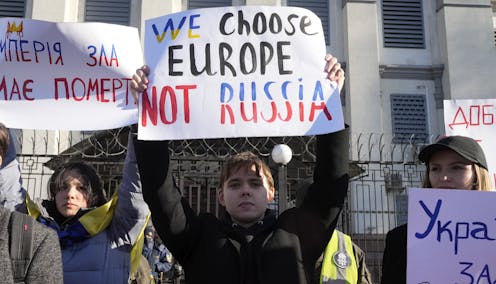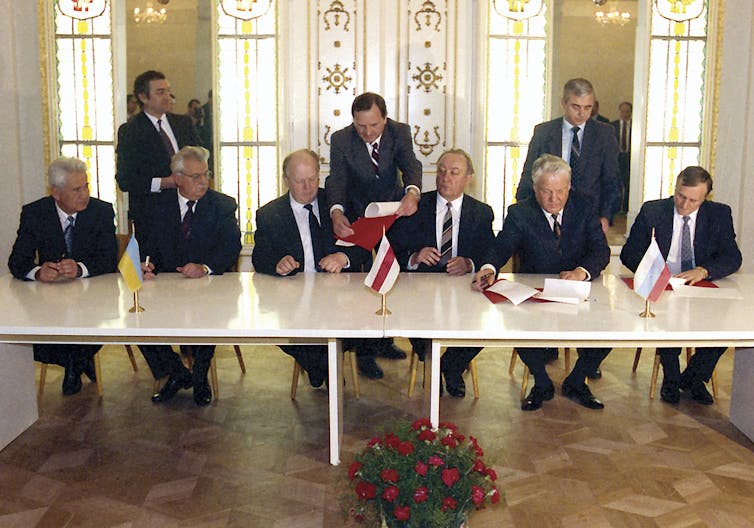
Three weeks have passed since since Russian President Vladimir Putin launched his violent, unprovoked invasion of Ukraine. While his stated objectives hinted at the elimination of Ukraine’s defence — demilitarization — and the removal of its political class — denazification — the rationale behind the invasion is harder to decode.
Putin’s worldview is based on an extreme version of the Russian nationalist narrative over Ukraine. A core aspect is the claim that Russian speakers (those who prefer to speak Russian) and ethnic Russians are basically “Russian” and under threat in Ukraine.
Read more: The history and evolution of Ukrainian national identity – podcast
On Feb. 23, Putin made the baseless accusation that the invasion was to protect Russian speakers who were allegedly being killed in the eastern Ukrainian province of Donbas. Another core aspect is the claim that an independent Ukrainian state is a foreign invention and a security threat to Russia. This is why, on Feb. 24, he claimed the “military operation” was an act of self-defence against NATO expansion.
Grounded in this worldview is Putin’s belief that Russians and Ukrainians are “one people” and Ukraine is merely an extension of Russia — an idea that can be traced back to the Russian imperial representation of Ukrainians (Little Russians) as junior brothers of Russians (Great Russians).
The birth of Ukrainian nationalism
The idea of Ukrainian self-determination can be traced to the 19th century, at a time when nationalist movements appeared all over Europe. Nationalism hinges on the claim that a culturally distinct nation has the right to self-rule.
In Europe, with the exception of the Balkans, nationalism was based around the claim of a distinct language. The early Ukrainian nationalists also believed that the unique Ukrainian vernacular, distinct from Russian and Polish, made the Ukrainian a nation.
While the modern idea of Ukrainian nationalism originated in Kyiv and eastern Ukraine — then under Russian imperial rule — nationalism as a mass movement developed in western Ukraine, which was then under Austro-Hungarian rule.
Austria, after 1867, recognized the rights of national minorities, such as the Ukrainians (then called Ruthenians). Western Ukrainians were able to establish their own schools and obtain political representation in local and national parliaments. The Russian empire, on the other hand, banned the public use and study of Ukrainian (then called “Little Russian”) and any political activity associated with it.
Austrian policy stands at the root of Putin’s belief that Ukrainian nationalism is a western invention seeking to weaken Russia. This is how the Russian empire saw it then: Ukrainian nationalism — the idea that Ukrainian identity is distinct from Russian and that Ukrainians should determine their own destiny — is fabricated and a threat to the Russian state. The Russian counter-narrative is that Russians and Ukrainians share the same history, and therefore have a common destiny.
The rise of the U.S.S.R.
Up until the First World War, Ukrainian nationalists in Russian imperial Ukraine believed they ought to have autonomy within the empire. With the collapse of the Russian monarchy in February 1917, a “Ukrainian National Republic” (UNR) was declared in Kyiv. After the Bolsheviks took power in Moscow, the UNR declared independence in January 1918.
Independence was short-lived because the main battlefield of the civil war in post-imperial Russia was in Ukraine, with four different armies engaged in battles: the Reds (Bolsheviks), Whites (counter-revolutionaries), Yellow and Blue (Ukrainian nationalists) and Greens (peasant anarchists). The entire civil war resulted in the death of 15 million people.
In the end, Ukraine was split in two again. The bulk of western Ukraine fell under reconstituted Poland, while the territories to the east — including Kyiv, Odesa, Kharkiv and Donetsk — were conquered by the Bolsheviks in what became the Soviet Union.

The Bolsheviks were Marxists who believed that nationalism was merely a bourgeois phenomenon that would eventually vanish under socialist rule. But Vladimir Lenin understood the power of nationalism, and in particular, the psychology of people who felt wronged by the sense of superiority of Russia.
This led to the Soviet Union recognizing Ukrainian as a separate language and granting Ukraine official “statehood” in the form of a Ukrainian Soviet Socialist Republic. The expectation was that the formal equality of nations would make nationalism dissipate. Yet Soviet statehood did not mean actual political autonomy. All main decisions were still made in Moscow, within the Communist Party of the Soviet Union.
The turning point
The key turning point of Ukraine’s relationship with Moscow came in the late 1920s and early 1930s. The Soviet Union had embarked on the “collectivization” of its agricultural sector, abolishing private property in rural areas and forming state-controlled farms in its place. The aim was to dispossess the peasantry in order to feed industrialization.
Ukraine, known as the “breadbasket” of the Russian empire because of its fertile farmland, resisted the impossible demands of grain requisition. The response by Joseph Stalin, who governed the Soviet Union at the time, was to associate this resistance with the anti-Soviet threat of nationalism, leading to a purge of the entire Ukrainian cultural elite in Soviet Ukraine.
This set the stage for the Holodomor — a famine in 1932-33 that killed four million Ukrainians. The term Holodomor comes from the Ukrainian words holod, meaning hunger, and moryty, to kill. In this view, the famine was not natural, but an act of murder. Areas of Russia also experienced a famine, but the death rate in Ukraine was much higher.
The famine devastated the social fabric of the countryside, where the Ukrainian vernacular was spoken and national identity had been flourishing. The 1937 purges, where three-quarters of a million people were murdered throughout the Soviet Union, further terrorized Soviet Ukraine. One of numerous mass graves was later exhumed in the central province of Vinnytsia.
Ukraine would not obtain its independence until the collapse of the Soviet Union in 1991.

Denazifying Ukraine
In televised remarks on Feb. 24, Putin justified his invasion of Ukraine by saying his offensive aimed to “demilitarize and denazify” the country. Since the 1960s, the main pillar of legitimacy in Moscow has been the Soviet victory over Germany — always presented as the victory over fascism — in the Second World War. Russia, as the successor of the Soviet Union, presents itself as an anti-fascist state.
In 1941, an ultra-nationalist movement — the Organization of Ukrainian Nationalists (OUN) — sided with German forces in 1941 during the invasion of western Ukraine, a territory that had only been annexed two years prior, after Germany and the Soviet Union carved up Poland. The Soviet annexation had destroyed civil and political society and led to mass arrests and deportations, leaving the underground OUN as the only viable Ukrainian force.
The OUN’s proclamation of “renewed” Ukrainian statehood in June 1941 was quashed by Germany. Their involvement with German battalions and militias turned them into “fascists” in Soviet propaganda, and Ukrainian nationalism became associated with fascism. Putin’s claim that he is “denazifying” Ukraine is a continuation of the wartime Soviet narrative that aims to delegitimize Ukrainian nationalism, or the very idea that Ukrainians determine their own destiny.
Read more: Putin's claim to rid Ukraine of Nazis is especially absurd given its history
Since the Maidan protests in Kyiv in November 2013 , politically visible far-right groups in Ukraine, such as Azov, have claimed OUN lineage. Russian propaganda has portrayed them as the drivers of Ukrainian politics. But Putin’s claims of “denazifying” Ukraine go far beyond these groups — his aim is to remove the entire Ukrainian political class “contaminated” by this foreign-fabricated idea of nationalism.
By Putin’s twisted logic, Volodymyr Zelensky, an eastern Ukrainian president of Jewish background who lost family in the Holocaust, heads a “Nazi” government. To Putin, Zelensky symbolizes the Ukrainian resistance to Russia over the status of Crimea and Donbas, security matters and the nature of the Ukrainian political system.
Nationalism, for Putin, means any behaviour or policy that is anti-Russian. He sees this in Ukraine’s determination to join the European Union and NATO, to make Ukrainian its sole official language and to promote a historical memory that emphasizes the divergent past (and future) of Ukrainians and Russians. Russia’s war in Ukraine is literally a war against Ukrainian statehood.
Dominique Arel does not work for, consult, own shares in or receive funding from any company or organization that would benefit from this article, and has disclosed no relevant affiliations beyond their academic appointment.
This article was originally published on The Conversation. Read the original article.







